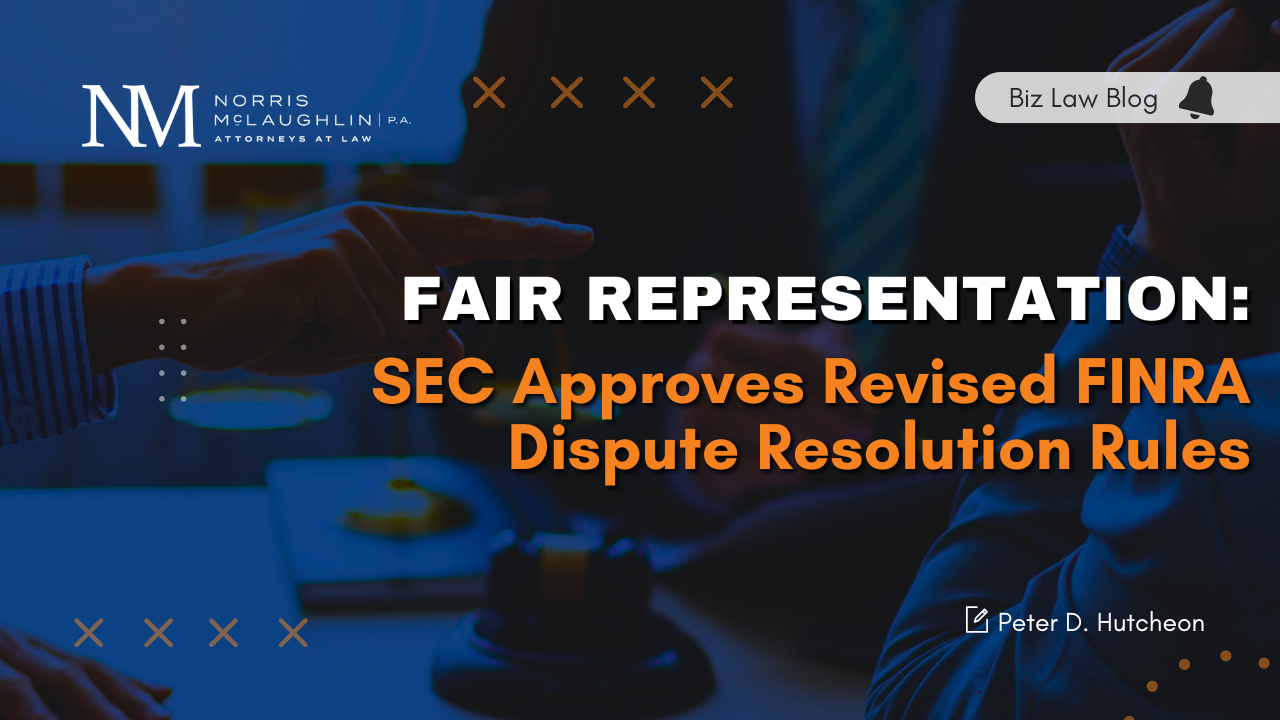Fair Representation: SEC Approves Revised FINRA Dispute Resolution Rules

A Brief History of Arbitration
Arbitration has been used as a process for resolving disputes between persons and countries for thousands of years. References to arbitration proceedings appear in histories of Imperial China, ancient India, Greece, and Rome. Indeed, Philip II of Macedonia (the father of Alexander the Great) engaged in arbitration proceedings to resolve territorial disputes in the fourth century B.C. When disputes arose among the Greeks and the Phoenician traders as each sought to control sea-going trade in the Mediterranean Sea, they resorted to arbitration to resolve conflicts.
As commerce between European parties evolved after the Dark Ages, merchants used arbitration – sometimes engaging arbitrators at trade fairs – to address disputes. As Eric S. Wolaver points out in his article from the U. PennLaw Review, “The Historical Background of Commercial Arbitration” (1934), guilds in England and elsewhere in Northern Europe frequently required their merchant members to settle disputes before arbitration panels, thus leading to the development of the Law Merchant. In addition, the Courts of the Cinq Ports in England and the city states of the Hanseatic League frequently used somewhat informal tribunals much akin to the arbitration panels, applying the Law Merchant to settle competing claims. English commercial disputes were regularly settled by arbitration after 1224 A.D. The Law Courts established in the 12th century by Henry II were far more concerned with real estate disagreements than commercial matters.
In fact, the Courts of King’s Bench were not well-geared to resolve commercial matters until the appointment of William Murray, the first Lord Mansfield, as Chief Justice of King’s Bench in 1756. Murray, a Scot, had been educated in the civil law system and single-handedly reformed British law to deal more effectively with commercial matters. As Wolaver writes, “it is common knowledge that until the time of Lord Mansfield, the English Court was poorly equipped to cope with merchant cases.”
Marco Polo also resorted to arbitration on his exploratory journey to China and back in the late 13th century. A few hundred years later, in 1872, the U.S. and Britain used arbitration to resolve American claims against Britain, arising from British support for the Confederacy during the Civil War.
Given this historical background, it is not surprising that when disputes arose between brokers with respect to securities transactions, arbitration would be employed. Beginning in 1817, members of the New York Stock Exchange could utilize Exchange-sponsored arbitration to resolve claims. That procedure was not offered to customers, i.e., investors, until 1872. The original dispute resolution system was operated by the New York Stock Exchange.
This arrangement was recognized in the Securities Exchange Act of 1934 (the “1934 Act”), but it was quickly apparent that no dispute resolution system existed for those trading in over-the-counter securities. That was corrected by passage of the Maloney Act of 1938, which amended the 1934 Act to include provisions relating to over-the-counter securities and led to the formation of the National Association of Securities Dealers (“NASD”). In 2007, the arbitration panels, regulations, and codes were transferred from the Exchange and from the National Association of Securities Dealers to a new, self-regulatory organization, the Financial Institution Regulatory Authority (FINRA). See Jill Gross’ article from The Journal of Dispute Resolution of the University of Missouri Law School, “The Historical Basis of Securities Arbitration as an Investor Protection Mechanism” (2016); and Roberta S. Karmel’s article from Stanford Journal of Law, Business, and Finance, “Should Securities Industries Self-Regulatory Organizations Be Considered Government Agencies?” (2008). As a Self-Regulatory Organization, FINRA is subject to the oversight authority of the U.S. Securities and Exchange Commission (the “SEC” or “Commission”).
Contemporary Arbitration Practices
Arbitration had become the dominant process for solving securities disputes after the U.S. Supreme Court, in two major holdings, held that investment agreements that mandated arbitration as the appropriate forum for dispute resolution were enforceable and not in violation of limitations under the Federal Arbitration Act. Those cases were Shearson/American Express v. McMahon, 482 U.S. 220 (1987) (claims under the 1934 Act) and Rodriquez de Quijas v. Shearson/American Express, 490 U.S. 477 (1989) (claims under the Securities Act of 1933). Generally, the arbitration panels included at least one industry person, who was presumed to have helpful industry knowledge. However, this attribute was frequently the source of complaints about the independence of the arbitrator decisions; indeed, one commenter, Jonathan Kurta, Esq., wrote an article on the subject titled “A Forum Controlled by the Securities Industry.”
In fact, on Jan. 25, 2022, the Superior Court for Fulton County, Georgia, vacated a $51,000 arbitration award to Wells Fargo Clearing Services, LLC, and Wells Fargo Advisors, LLC, based on a finding that the FINRA arbitrators who made the award were too close to Wells Fargo. Although that judgment was reversed on appeal, FINRA felt the need to have a thorough independent examination of the procedures for selecting arbitration panel members. Christopher W. Gerold, the former Chief of the New Jersey Bureau of Securities and now a partner in the law firm of Lowenstein Sandler, provided FINRA with a lengthy investigation report on June 28, 2022, which contained several recommendations to improve the arbitration system, but did not find any signs of material abuses in the existing process.
FINRA took several corrective actions recommended by Gerold’s Report. FINRA also considered other steps to improve the quality and transparency of the arbitration process, including the quality of the representation of investor claims before arbitration panels. After its formation in 2007, FINRA consolidated its arbitration and mediation processes into a separate section called the Dispute Resolution Services unit (“DRS”). DRS maintains 69 hearing locations, at least one in every state plus Puerto Rico and Washington, D.C.
FINRA has long had concerns about who represented investors in arbitration proceedings. An investor seeking to recover money in a proceeding could select an attorney or some other person to assist them in making their case. But not all attorneys may appear in FINRA tribunals. Some states have determined that representing investors in those tribunals is “the practice of law,” so that the investor’s representative MUST be an attorney admitted to practice in the state involved AND be in good standing with the attorney regulator in that state. Indeed, in an early FINRA proceeding in New York, an investor was represented by a New Jersey attorney. The New York State Bar Association objected, asserting that representation by an out-of-state attorney involved the unauthorized practice of law. New York has subsequently passed legislation that specifically allows out-of-state attorneys and non-attorneys to represent investors in arbitrations. Other states (Arizona, Arkansas, California, Florida, Illinois, Michigan, Ohio, and Oregon, according to published reports) do not allow out-of-state attorneys and/or non-attorneys to appear in arbitration, holding that would constitute the criminal act of the unauthorized practice of law.
Non-Attorney Representatives (“NARs”)
A second issue has arisen concerning paid non-attorney advisors (“NARs”). On Nov. 28, 2018, the Professional Responsibility Committee of the New York City Bar issued a report titled “Non-Lawyers Representing Customers in FINRA Dispute Resolution Arbitrations.” It stated:
…both FINRA and the United States Securities and Exchange Commission (“SEC”) have warned investors against dealing with these non-lawyer firms. FINRA warned, ‘In addition to the original money you lost, you now may lose more money at the hands of professional con artists.’ The SEC likewise urged investors to ‘think carefully before paying money for asset recovery services that may be fruitless.’
In 2017, FINRA had issued a Regulatory Notice asking the affected community of investor organizations and brokers whether it should limit or even bar the use of NARs. That effort elicited many comments concerning “issues of competency and professionalism.” NARs were seen as discourteous, poor pleadings drafters, and makers of baseless objections. In addition, there was and is no body or authority to discipline ineffective and/or disruptive NARs. Indeed, statistical studies show that investors represented by NARs were significantly less successful in their arbitrations.
A third matter of concern to FINRA, and in turn to the SEC, was the status and oversight of law students representing investors in bringing claims. While law students have some training, the acceptance of their appearances and the system of overseeing them were not clear. Here again, adoption of policies and procedures addressing the involvement of law students would enhance the level of investor representation. In addition, challenges to a particular investor representative frequently caused significant delays in the arbitration proceedings in which they were involved. Faced with these concerns about FINRA arbitration, in addition to the challenges raised about the selection of arbitrators, FINRA was determined to act.
After much internal discussion, on Oct. 5, 2023, FINRA filed with the SEC proposed revisions to the Codes of Arbitration and of Mediation governing DRS. That proposal was published in the Federal Register on Oct. 13, 2023, with comments due by Nov. 3, 2023, later extended to Jan. 11, 2024. On Jan. 11, the SEC approved the FINRA proposal and published a notice on this.
One of those revisions requires that any challenge to the qualifications of an investor’s representative be made outside the arbitration proceedings and “shall not stay or otherwise delay the [arbitration or mediation] proceeding in the absence of a court order.” Second, attorneys are ineligible to act as representatives if they are disqualified under the law of the hearing site involved (i.e., the laws of the several states, the District of Columbia, or any relevant “commonwealth, territory, or possession of the United States”). Third, any attorney appearing in a FINRA arbitration proceeding must, in addition to not violating any “unauthorized practice of law” provision, be:
- in good standing with the relevant attorney licensing authority; and
- not “suspended from, or denied the privilege of, appearing or practicing before the Commission.”
The revisions also changed the ability of an investor to use a Non-Attorney Representative (“NAR”). First no non-attorney is permitted to represent an investor in a FINRA proceeding if such would constitute the “unauthorized practice of law.” The revisions also entirely bar the use of NARs, with FINRA stating “that compensated NARs have a pecuniary incentive to engage in misconduct when seeking new client relationships or bringing claims in the DRS forum, and that parties harmed by such conduct lack recourse against compensated NARs who are not directly regulated.” In addition, if under the revised Codes an investor chooses to use an NAR, both the NAR and the investor must submit, prior to the beginning of a proceeding, signed written representations that NO compensation is being paid to the NAR.
Finally, the revisions codify the requirements governing law students serving as investor representatives. The student must:
- be enrolled in a law school;
- participate in an appropriate law school clinical program or equivalent; and
- practice under the supervision of a properly licensed attorney.
The revisions specifically note that representation by a law student may be subject to state or territorial rules that govern such practice, including rules applicable to the supervising attorneys. One of the strongest proponents of the revisions concerning law students in clinical programs came from the Securities Arbitration Clinic of St. John’s University School of Law.
The Jan. 11, 2024, SEC notice concludes:
For the reasons set forth above, the Commission finds that the proposed rule change is consistent with Section 15A(b)(6) of the [1934] Act, which requires, among other things, that FINRA rules be designed to prevent fraudulent and manipulative acts and practices, promote just and equitable principles of trade, and, in general, protect investors and the public interest.
If alive today, Lord Mansfield would be pleased with FINRA for making these changes.
If you have any questions or concerns about the SEC or FINRA revisions, please do not hesitate to contact me at pdhutcheon@norris-law.com.




